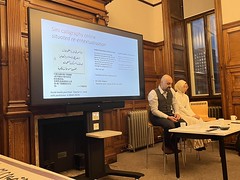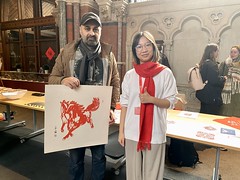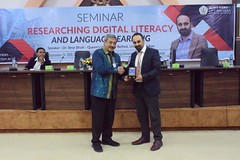By Ibrar Bhatt
I have been busy writing my PhD so haven’t updated this blog for a while. Thesis writing is taking up a lot of my mental space as I get the ideas, storyline and contentions to coalesce and cohere in a manner suitable for such a piece of work.
But initial data analysis has lead me to a series regarding practices of digital literacies during the writing of assignments, and one of them is the concept and practice of ‘curation’ as a digital literacy, and what the implications are for curation practices to be better understood, theorised, and subsequently harnessed for educational purposes. My PhD thesis (Bhatt, 2014) contains some ideas that are worth disseminating out to collide with others as part of what I believe is a public conversation. [Aside: see this brief lecture by Steven Johnson on the ‘collision’ of ideas and the sharing of half-baked hunches]
The word ‘curation’ comes from the Latin root curare, meaning ‘to cure’ or ‘to take care of’ and historically relates to any processes of organisation, collation, judicious selection (usually for presentation), and even curing and preserving. The term has usually been employed to describe such work which is carried out in museum settings, and has now evolved to describe what is often done in digital environments and online spaces (see http://curationnation.org). To better explain curation in digital environments, the information theorist Edward Tufte (1990) provides a useful and elaborate explanation of the kinds of practices that people tend to do in “information thick worlds”. To Tufte, these are the abilities to:
Select, edit, single out, structure, highlight, group, pair, merge, harmonize, synthesize, focus, organize, condense, reduce, boil down, choose, categorize, catalog, classify, list, abstract, scan, look into, idealize, isolate, discriminate, distinguish, screen, pigeonhole, pick over, sort, integrate, blend, inspect, filter, lump, skip, smooth, chunk, average, approximate, cluster, aggregate, outline, summarize, itemize, review, dip into, flip through, browse, glance into, leaf through, skim, refine, enumerate, glean, synopsize, winnow the wheat from the chaff, and separate the sheep from the goats.
(Tufte, 1990, 50)
Without going into too much detail here in a blog post, but drawing from Tufte, some aspects of my PhD data reveal different instances of digital curation in the completion of student work, during the writing of assignments. These processes are, as Tufte outlines, about anthologising older content to produce new content and creating a new experience for readers, by giving a new life (or new ‘reality’) to an older text. This is curation as a set of digital literacy practices.
Everyday examples of such practices include retweeting, ‘liking’ on Facebook, collating tweets and other updates into thematic collections (e.g. Storify), the rewriting or rehashing of digitally archived previous text for new purposes (sometimes called patch-writing), etc. In this respect, prolific Web users have often made themselves effective digital curators by searching and locating information, then creating a new experience by re-contextualising it. A currently famous example is the curation work of Maria Popova, and her blog updates on Brain Pickings. Popova’s curation practices are summarised in the diagram below:

Source: http://www.fastcompany.com/3018236/most-creative-people-2012/51-maria-popova
Digital curation therefore is not just about finding relevant material, although that is a significant part of it, but is also about creating a specific and unique experience by utilising the resulting materials which then become contextualised within a new space. A curator, therefore, whether she is a journalist-by-proxy such as Popova or a student completing an assignment in a classroom, not only collects and interprets, but also creates a new experience with it. In this respect, curation is a process of problem solving, re-assembling, re-creating, and stewardship of other people’s writing. Breathing new life into older texts is a complex skill and allows a reader to enter into a conversation with the writers of those texts, in a Bakhtinian sort of way – all writing contains the voices of other authors. How the processes of curation can lead to new forms of writing, and how this can a) be acknowledged, and b) incorporated into the ways students are assessed on their writing then becomes a challenge.
My research is influenced by the field of Science and Technology Studies (STS), revolutionary at the time of its conception for unpacking the ‘secret’ workings of science and its practices of knowledge creation. Bigum et al (2014) write:
Looking at how scientists actually do science, STS scholars came to see that accounts of science as products of the scientific method glossed the messiness, noncoherence and fuzziness of what went on in the laboratory. To Bruno Latour, in the early days of STS, science was Janus -like, with two contradictory faces: science in the making and ready-made science.
Some aspects of my data (Bhatt, 2014) reveal that in the writing of assignments, previous academic work gets mobilised into action with old assignments used as a validation for current work. Stuff is ‘rehashed’ and ‘remixed’ for a new purpose, and subsequently re-labelled as ‘new’ work.
Students’ previous, even non-academic, work gets linked to assignments where relevant. Texts written at different times are then fine-tuned, tweaked and glossed for a different intention. Is this cheating? Or working efficiently?
Works of others are collated through prolific Web searching and sometimes linked to, involving signposting and contextualisation through its integration into the new tasks.
In each of these cases, and in MANY other aspects of my research which I will not go into here in a blog post, there is the re-purposing of text in a manner commensurate with curation as defined above. It’s not all benign or received as ‘honest’ work upon assessment, but I am not going to get into that yet. I just want to better understand what is actually happening and what can be done to harness some of these skills: some of these other literacies hidden away within more acknowledged literacies like Matryoshka dolls.
Maybe, if we go back to Bakhtin, all writing and forms of production contain dialogue so are a form of curation?
More on curation and other aspects of my digital literacies analysis to come…
References:
Bhatt, I. (2014). A sociomaterial account of assignment writing in Further Education classrooms. (PhD thesis), School of Education, University of Leeds.
Bigum, C., Rowan, L., Wright, S., Hamilton, M. & Haxell, A. (2014). Looking for black cats and lessons from Charlie: exploring the potential of public click pedagogy (February 2014 version of Working paper) [Online]. Edinburgh. Available: http://chrisbigum.com/downloads/PCP-NLC.pdf [Accessed 9th April 2014].
Tufte, E. R. (1990). Envisioning information, Cheshire, Conn.: Graphics Press.
A pdf of this post is also available:
Curation as Digital Literacy Practice _ Ibrar’s space
Categories: Digital Literacies, PhD Reflections, Research, Technologies, theory











Excellent post, thank you! I have added it to a list of general references on curation I have assembled on a wiki here: http://curation.wikispaces.com/General+References. I look forward to your future posts on curation! Thank you for sharing this one!
Thank you for the comment and inclusion as a reference on your list. I will definitely take a look at some of the articles there.
I enjoyed reading this too and I have been working in this area for a few years now. I had a book published by Palgrave in their Digital Education series based on case studies of autobiographical digital video by younger learners. The book is called “Digital Media and Learner Identity: The New Curatorship” and came out at the end of 2012. I hope you find it useful. There are some related pages listed on my staff page at the London Knowledge Lab too at http://www.lkl.ac.uk/people/potter and I sometimes write on a blog about it and related issues at http://digitalcurationandlearning.wordpress.com/
Thank you John, and I intend to explore your work after Kate (Sheffield Uni) tweeted me your link.
Your post here especially resonates:
http://digitalcurationandlearning.wordpress.com/2014/02/01/curatorship-is-a-new-literacy-practice/
To me it’s about digging for those practices that may get elided from view, or glossed over, and (a) understanding them better, then (b) harnessing them for educational purposes.
This is only one aspect of digital literacies that I have picked up on in my research. There are many more – it’s amazing what you find when you go digging. Referring to your work will enhance the curation component of my thesis – many thanks.
This grabbed me the most, though you don’t expand here:
“Stuff is ‘rehashed’ and ‘remixed’ for a new purpose, and subsequently re-labelled as ‘new’ work… . Students’ previous, even non-academic, work gets linked to assignments where relevant. Texts written at different times are then fine-tuned, tweaked and glossed for a different intention. Cheating? Or working efficiently?”
This reawakens considerations I’ve previously had about the taboo-ness of students reusing some of their previous work in new assignments, for the same class or even future. Are we so wrought with concern over plagiarism and accountability that we stifle ongoing improvement of a student’s writing skill or better yet, investigation within their discipline? Can we look at an entire program as a scaffolded work instead of isolated bits that somehow magically come together as a whole?
Reblogged this on broadyesl.
Hi,
Thanks for the comment.
The moral panic surrounding plagiarism and the re-use (and re-hashing, reformulating, etc.) of prior work sometimes takes the attention away from complex and interesting secret literacy practices, hidden away like matryoshka dolls in a greater task like an assignment. Even ‘sub-rosa’ literacy practices (Perry Gilmore).
How these practices can be harnessed is a pedagogic challenge, as you suggest.
A kind of portfolio comes to mind, the like of which is discussed here in this blog post:
http://luke-callahan.com/students-must-curate-create-a-portfolio/
loving your post on the concept of digital literacy and particularly the Tufte descriptors!
Indeed curation is for learning, teaching, researching… order changing according to activities in a university setting, but should also be a way of life for curious and creative human beings.
Will read further into your blog and references
looking forward to your PhD thesis
Ibrar, happy to have found you and your excellent writing.
I think you hit the nail right on the head when you start to hint at the falsehood of considering learning something that is held or known by someone and needs to be taught to others (teaching) versus the idea of learning as a path of personal discovery and connecting dots and hunches you already have in your head.
I like to think of curation as an ideal approach for learning, because it does not assume that there is one good master source, but it attaches all of its essence to the ability to create new value by reassembling and remixing, under a new light, what already exists out there.
In this respect, curation could provide a truly transformative approach in the way anyone can learn more about any topic. Curation is as learning by swimming, versus learning by reading a book on how to swim.
Hello Robert, and thank you for your comment and insights. I totally agree with you about learning through curation.
The challenge is, as you say, uncovering these usually elided literacy practices, acknowledging them, then harnessing them. I look forward to reading more of your stuff ..
I enjoyed reading this elaboration of this post, by another blogger:
http://impedagogy.com/wp/blog/2014/08/15/curation-favors-the-connected-mind/#comment-1703
Reblogged this on limfablog.
Reblogged this on Pondering on Literacies in Contemporary Societies and commented:
The best definition of curation by Ibrar Bhatt!!!